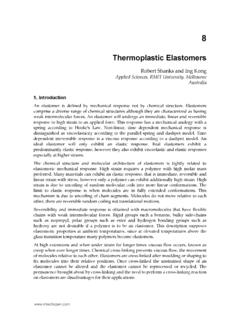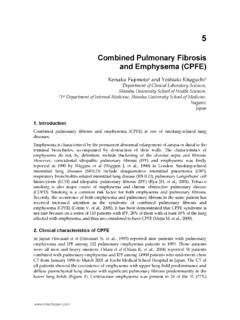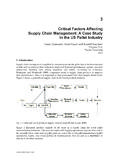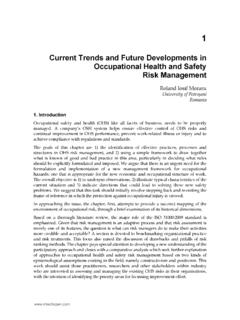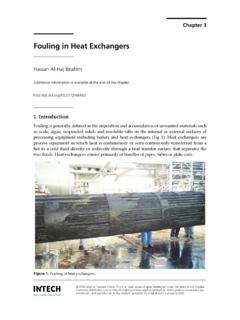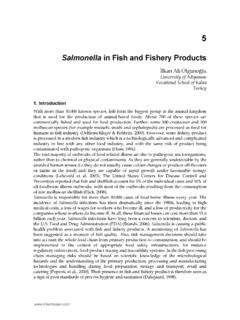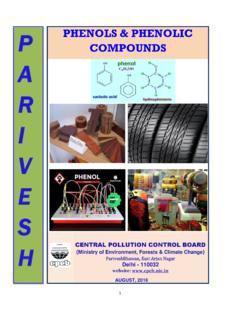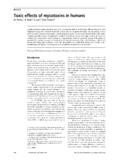Transcription of Treatment Technologies for Organic Wastewater - Open
1 Chapter 11 2013 Li et al., licensee InTech. This is an open access chapter distributed under the terms of the Creative Commons Attribution License ( ), which permits unrestricted use, distribution, and reproduction in any medium, provided the original work is properly cited. Treatment Technologies for Organic Wastewater Chunli Zheng, Ling Zhao, Xiaobai Zhou, Zhimin Fu and An Li Additional information is available at the end of the chapter 1. Introduction Resources of Organic Wastewater There are several contaminants in Wastewater , with Organic pollutants playing the major role. Many kinds of Organic compounds, such as PCBs, pesticides, herbicides, phenols, polycylic aromatic hydrocarbons (PAHs), aliphatic and hetercyclic compounds are included in the Wastewater , and industrial and agricultural production as well as the people living could be the source of Organic Wastewater endangering the safety of the water resource [1].
2 The Wastewater of the farmland may contain high concentration of pesticides or herbicides; the Wastewater of the coke plant may contain various PAHs; the Wastewater of the chemical industry may contain various heterogeneity compounds, such as PCB, PBDE; the Wastewater discharged by the food industry contains complex Organic pollutants with high concentration of SS and BOD; and the municipal sewage contains different type of Organic pollutants, such as oil, food, some dissolved organics and some surfactants. These Organic pollutants in water can harm the environment and also pose health risks for humans. Common poisonous substances in Organic Wastewater The Organic pollutants in the Wastewater could be divided into two groups according to their biological degradation abilities.
3 The Organic pollutants with simple structures and good hydrophilicity are easy to be degraded in the environment. These Organic pollutants, such as polysaccharide, methanol could be degraded by the bacteria, fungus and algae. However, some of them, such as acetone and methanol, could cause acute toxicity when existed in Wastewater at a high concentration. On the other hand, the persistent Organic pollutants, such as PAHs, PCBs, and DDT, are very slowly metabolized or otherwise degraded. Some of them, for example, the pesticides were widely used for several years. Although their concentration as well as the cute toxicity in the Wastewater is lower than the soluble Organic pollutant, they can be sequestered in sediment and exist for decades, and Water Treatment 250 transport into the Wastewater and then the food chain.
4 The POPs are lipid soluble, and many of them mentioned above are carcinogenic, teratogenic, and neurotoxic. Since they are persistent, long way transported and toxic , these Organic pollutants draw more attentions. The classic poisonous substances in Organic Wastewater are as follow: 1. Water Organic matter Water Organic matter is the genetic name of the Organic compounds in the sediment and Wastewater . Generated from the residues of the animal, plants and microorganisms, the water Organic matters could be divided into two categories: one is non - humic, which is composed of the various Organic compounds of organisms, such as protein, carbohydrate, Organic acids, etc., the other is a special Organic compounds named humus. Water Organic matter could affect the physical and chemical properties of the water, and could also influence the self-purification, degradation, migration and transformation process in the water.
5 2. Formaldehyde Formaldehyde is an Organic compound with the formula CH2O. The main sources of formaldehyde are Organic synthesis, chemical industry, synthetic fiber, dyestuff, wood processing and the paint industry emissions of Wastewater . With a strong reducibility, formaldehyde could easily combine with a variety of material, and is easy to be together. Formaldehy is a stimulus to skin and mucous membrane. It could enter the central nervous of human body and cause retinal damage 3. Phenols Phenols are a class of chemical compounds consisting of a hydroxyl group (-OH) bonded directly to an aromatic hydrocarbon group. The phenol in the Wastewater mainly comes from the coking plant, refining, insulation material manufacturing, paper making and phenolic chemical plant.
6 Phenol is known human carcinogen and is of considerable health concern, even at low concentration. Phenol also has potential to decrease the growth and the reproductive capacity of the aquatic organisms. 4. Nitrobenzene Nitrobenzene is an Organic compound with the chemical formula C6H5NO2. It is produced on a large scale as a precursor to aniline. In the laboratory, it is occasionally used as a solvent, especially for electrophilic reagents. Prolonged exposure may cause serious damage to the central nervous system, impair vision, cause liver or kidney damage, anemia and lung irritation[2]. Recent research also found nitrobenzene as a potential carcinogenic substance. 5. PCBs PCBs are biphenyl combined with 2 to 10 chlorine atoms. PCBs are widely used as dielectric and coolant fluids, for example in transformers, capacitors, and electric motors, and various kinds of PCBs could be found the Wastewater of this factories[3].
7 PCBs are carcinogenic, and could accumulate in adipose tissue, causing brain, skin and the internal organs disease, and Treatment Technologies for Organic Wastewater 251 influence nerve, reproductive and immune system. PCBs also have shown toxic and mutagenic effects by interfering with hormones in the body. PCBs, depending on the specific congener, have been shown to both inhibit and imitate estradiol. 6. PAHs PAHs are recalcitrant Organic pollutants consisting of two or more fused benzene rings in linear, angular, or cluster arrangements. PAHs occur in oil, coal, and tar deposits, and PAHs in the aquatic system could come from accidently leaking, atmosphere deposition and contaminated sediment release. The concentration of PAHs, especially the PAHs with high molecular weight, in the water is usually low in the water owing to their hydrophobia property, but they are still among the most problematic substances as they could accumulate in the environment and threaten the development of living organisms because of their acute toxicity, mutagenicity or carcinogenity [4].
8 7. Organophosphorus pesticide The Wastewater of organophosphorus pesticide manufacturers often contains a high concentration of organophosphorus pesticide, intermedia productions and degradation productions, and the Wastewater from the farmland could contain some of this pesticide since this substance could exist in the environment for a period of time. The discharge of water contained organophosphorus pesticide could cause serious environmental pollution. Some organophosphorus pesticides have acute poison on the people and livestock. In spite of the severe toxicity of the organophosphorus pesticide, it is easy to be degraded in the environment [5]. 8. Petroleum hydrocarbons The petroleum hydrocarbons in the water system mainly come from the industrial Wastewater and municipal sewage.
9 The industry, such as oil exploration, oil manufacture, transportation and refining could produce the Wastewater with a mixture of various petroleum hydrocarbons. The petroleum hydrocarbons are toxic towards aquatic living things, and they could also aggravate the water quality by forming a layer of oil film, which could decrease the oxygen exchange of the air and water body. 9. Atrazine Atrazine is the most widely used herbicide in conservation tillage systems, which are designed to prevent soil erosion. This chemical herbicide could stop pre- and post-emergence broadleaf and grassy weeds in dry farmland, and increase the production of the major crops [6]. The Wastewater contained atrazine mainly comes from the chemical industry manufacturing this product and the farmlands which are over loaded.
10 This substance could remain in the environment for a period of time, and it has been detected in the surface water and groundwater of many countries and regions. Atrazine could volatilize at high temperature and release poisonous gas such as carbon monoxide, nitrogen oxides, which could irritate people's skin, eyes and respiratory tract. Besides, atrazine also has a potential cause of birth defects, low birth weights and menstrual problems when consumed at concentrations below federal standards. Water Treatment 252 Environmental hazards of Organic Wastewater High mount of hydrophilic Organic pollutants, such as Organic matters, oil could consume a large amount of soluble oxygen. The acute toxicity and high quantity of oxygen demand could worsen the water quality and lead to great damage to the aquatic ecological system.


